The global B2B SaaS market has skyrocketed from just $31.4 billion in 2015 to $197.29 billion in 2024.
With this surge comes serious opportunity but also, competition.
To thrive in this industry, marketers need the right B2B SaaS marketing mix with plenty of arrows in their quiver.
In this post, we’ll take a deep dive into B2B SaaS marketing and cover the top 10 strategies for success.
What Is B2B SaaS Marketing?
This is a form of marketing that focuses specifically on promoting business-to-business (B2B) software-as-a-service (SaaS) products.
Some popular examples of B2B SaaS companies include Shopify, Zoom, Salesforce, HubSpot, Slack, and Mailchimp, just to name a few.
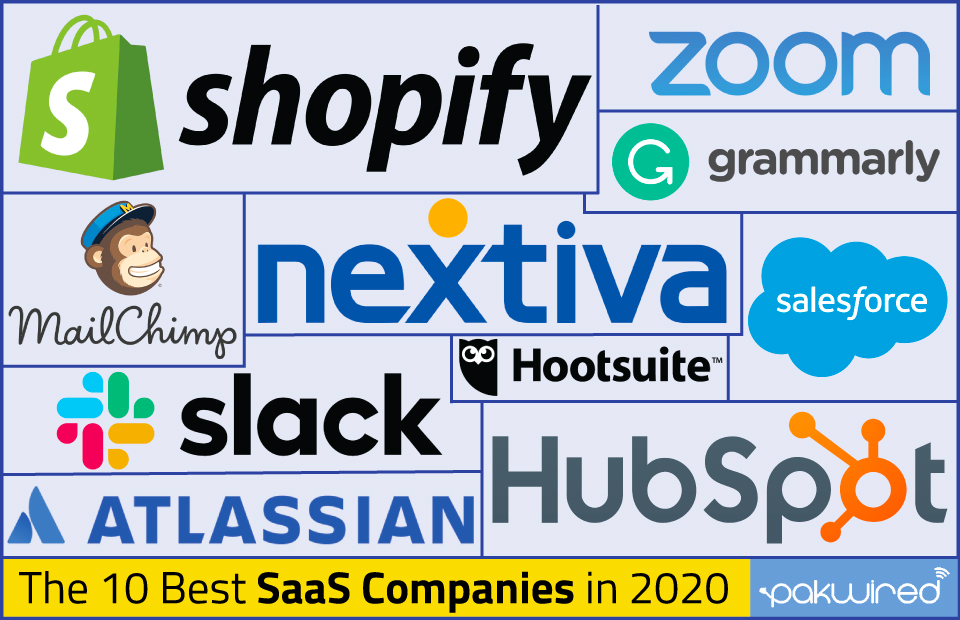 Source: PakWired
Source: PakWired
A key difference between a B2B SaaS product and a traditional computer application software is that a B2B SaaS product is usually subscription-based.
As a result, this changes the approach marketers must take. They will need to have a longer view to succeed.
This quote from Josh Daugherty of DemandJump summarizes it perfectly.
“While traditional marketing sells a tangible, easily-defined product, B2B SaaS marketers are instead selling a service — one that is often subscription-based. So, not only do these marketers need to build value for an intangible product, but they also need to be able to build value over time.”
In other words, it’s about more than merely moving leads through the B2B marketing funnel to make an initial purchase.
A successful B2B marketing strategy will also strive to build loyalty, keep the maximum number of users renewing their subscriptions to increase customer retention, and look to encourage users to upgrade when possible.
So besides simply converting a lead into a new customer, you also want to optimize the existing customer experience and never stop communicating for a well-rounded, ongoing SaaS marketing strategy.
Common B2B Marketing SaaS Goals
Although the exact goals can vary somewhat, here are some common B2B marketing goals that are essential for getting a campaign off the ground and increasing the odds of sustained success.
For any B2B SaaS company that implements a freemium model, one of the main goals is acquiring new free users.
Woopra, for example, offers the “Core” version of B2B marketing analytics, which is free and offers 500k actions per month, 90-day data retention, core analytics, and over 30 integrations.
 Source: See pricing here
Source: See pricing here
The long-term goal is to create a fantastic customer experience and ultimately convert a sizable chunk of free users to paid users.
But the first step is to get our foot in the door with new free users. And a well-run digital marketing campaign can do just that.
Another major goal is increasing your number of sales leads and demo requests.
For instance, with Woopra, we have a page where leads can conveniently schedule a demo at a time that’s good for them and talk to one of our in-house experts.
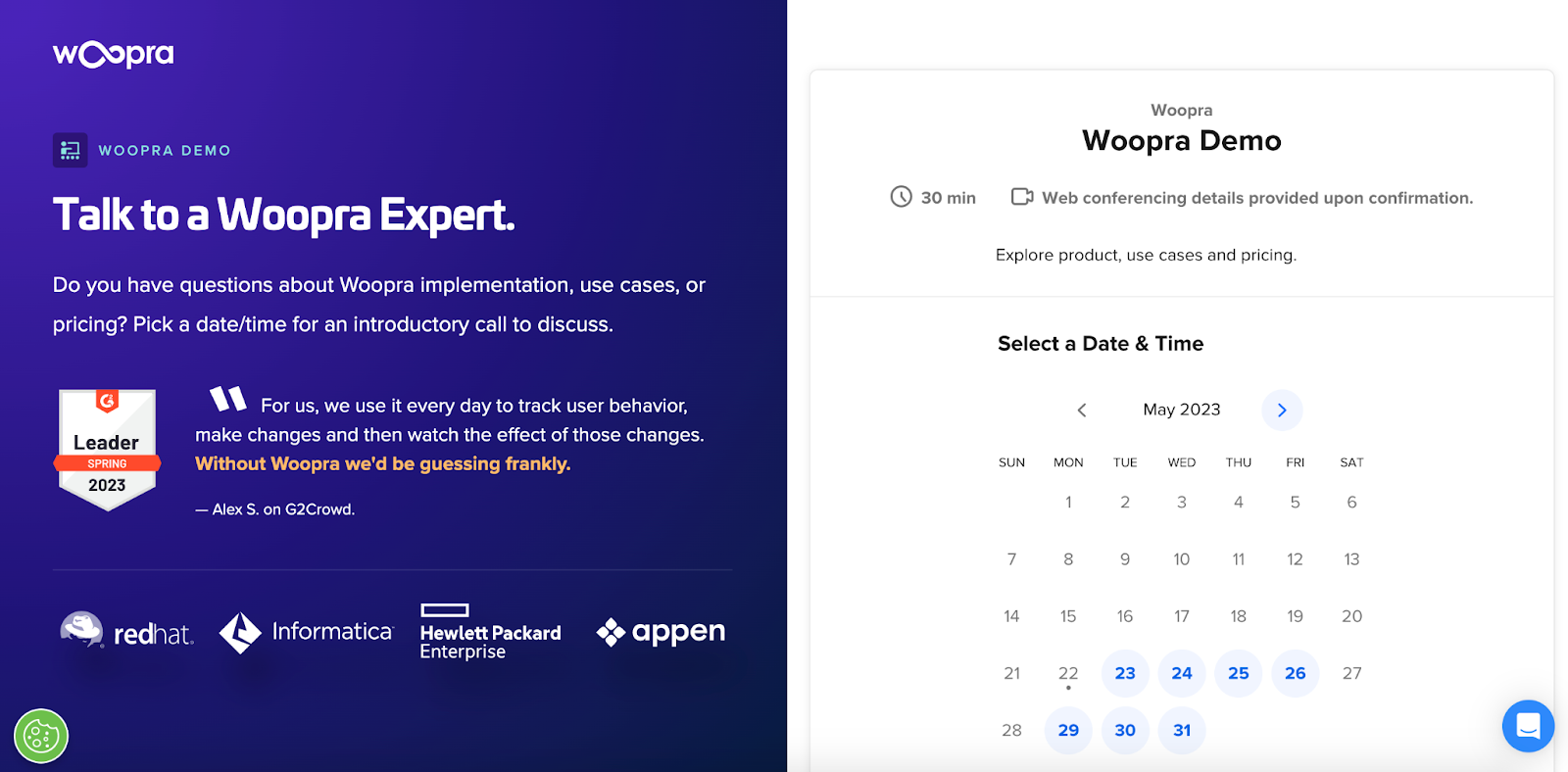
An integral part of a SaaS marketing campaign is creating a framework that funnels qualified leads to a demo page where they can take the next step.
Besides that, B2B marketers obviously want to maximize their number of paid subscriptions.
As we just mentioned, this often involves getting free users to buy the paid version of a product.
However, this can also mean getting brand-new users to pay for a subscription right off the bat without testing the waters.
And for a SaaS business without a freemium model, this will be even more important.
Finally, there’s plan upselling where you look to maximize the number of paid users that upgrade their plans.
Say, for example, a Mailchimp user currently has the “Essentials” plan that starts at $13 per month.
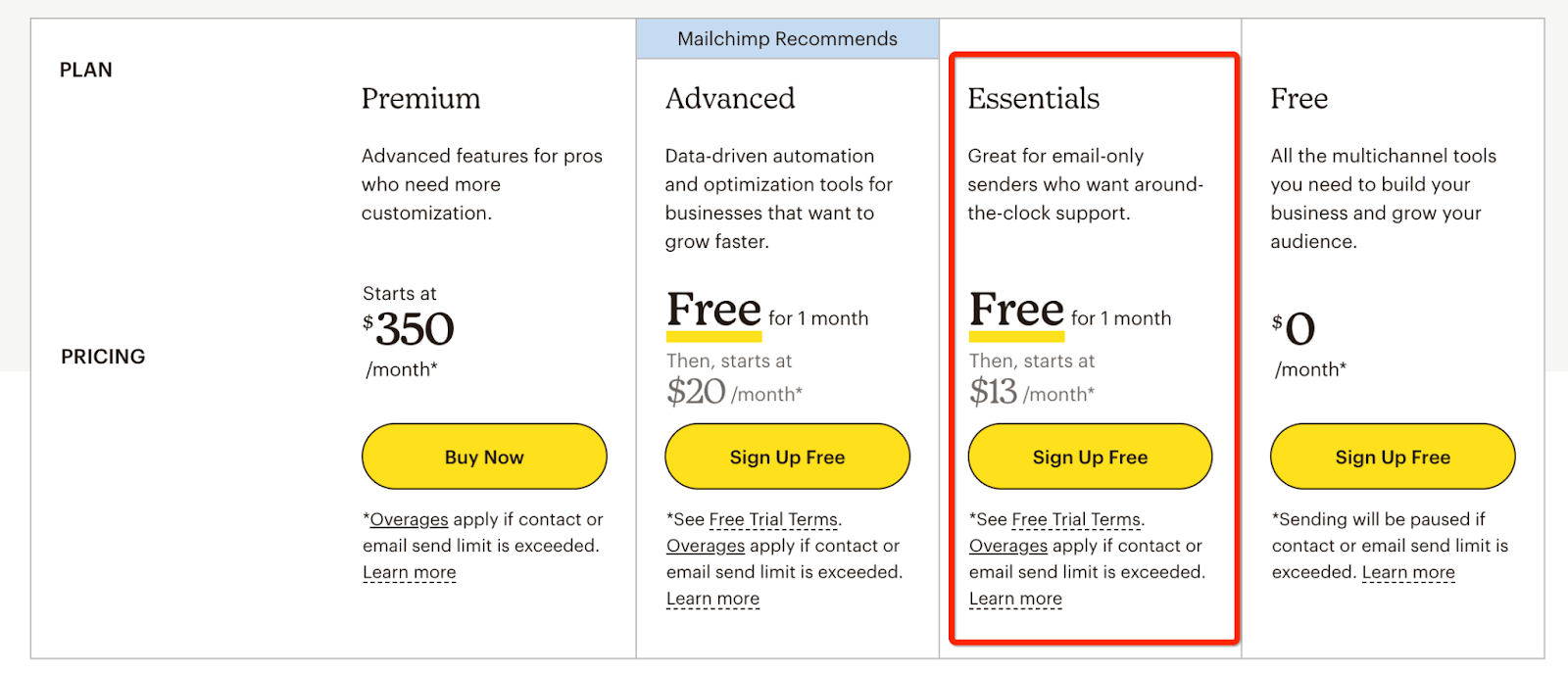
The goal of a SaaS marketer may be to bump them up to the “Advanced” plan that starts at $20 per month.
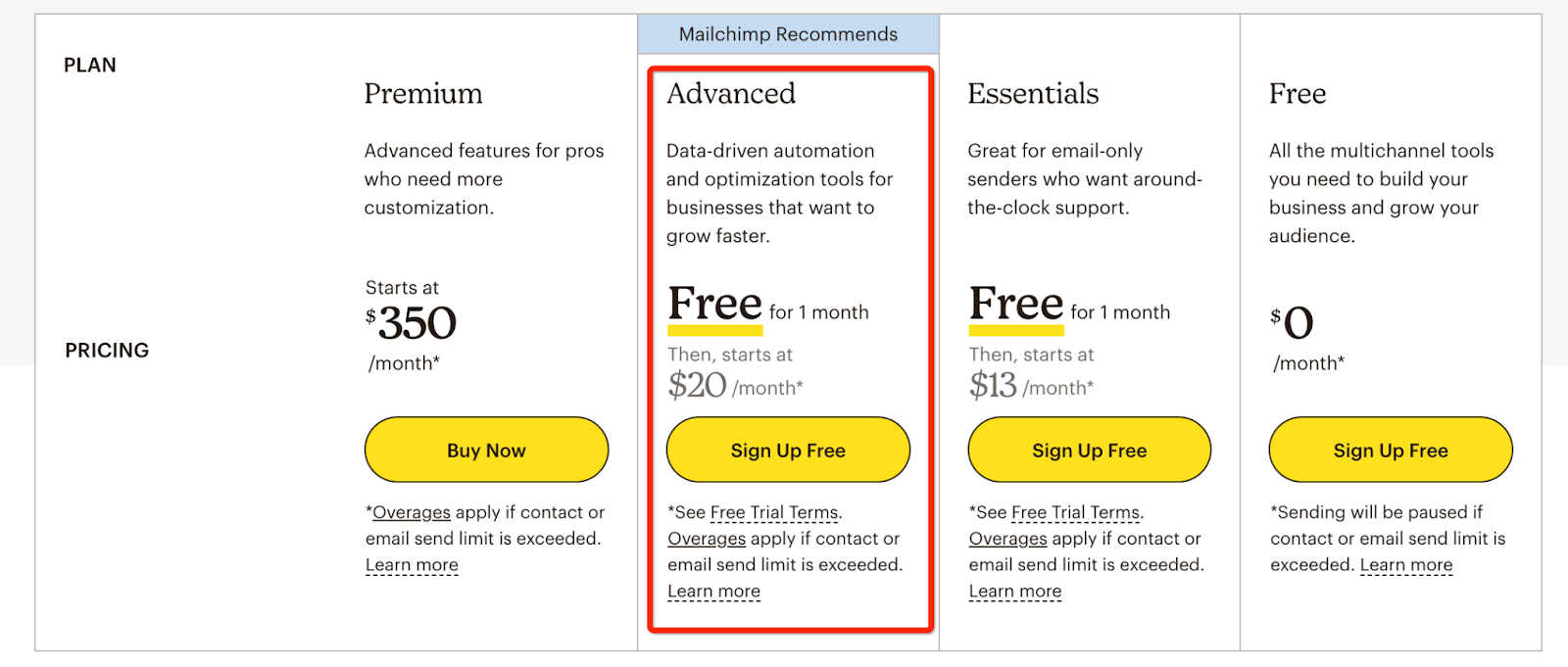
Again, unlike marketing for many other products that are “one and done,” B2B SaaS marketing is more of an ongoing process.
Therefore, you need to look beyond simply making the initial sale and be equally focused on providing a continually good experience.
B2B SaaS Marketing Strategies
Now that we know what B2B SaaS marketing is and the core goals behind it, let’s discuss 10 specific strategies that have proven to get results.
Know Your Brand Positioning
This refers to identifying your unique value proposition (UVP) and what your company can offer a potential customer that your competitors can’t.
This graphic from Qualtrics does an excellent job of illustrating what brand positioning is and why it’s so important.
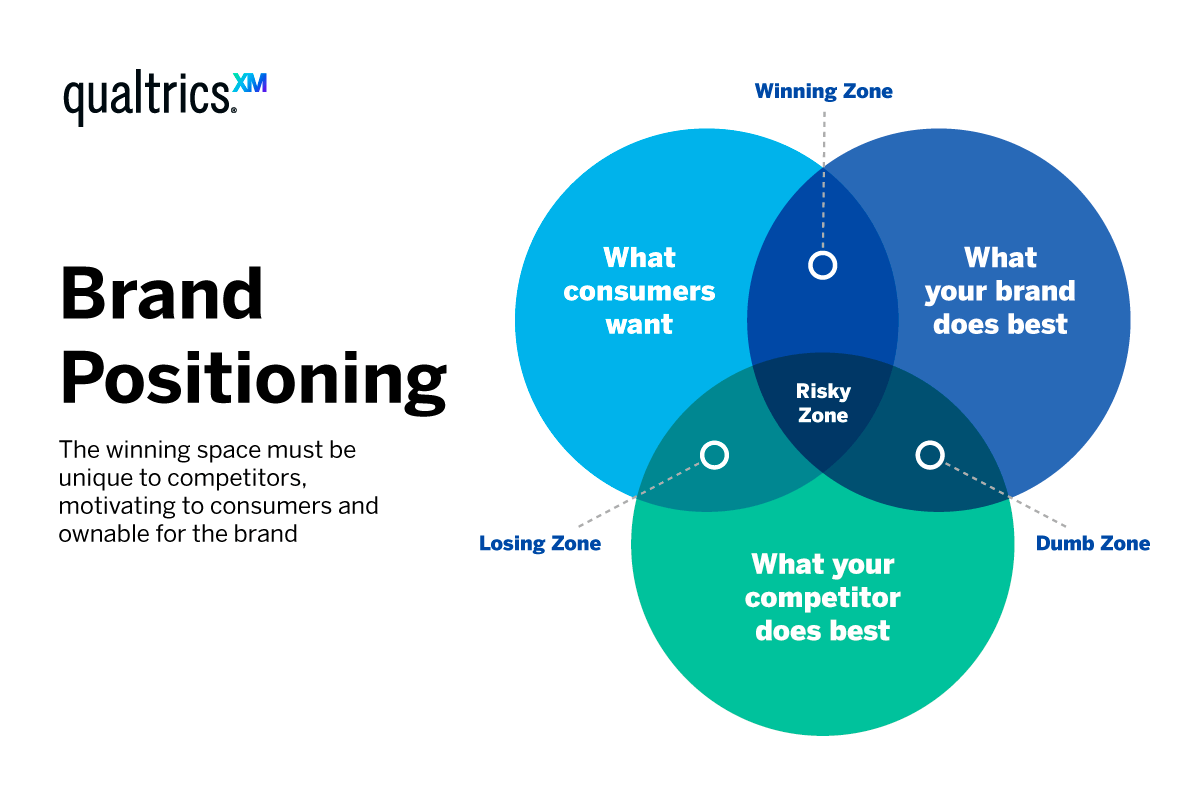 Source: Qualtrics
Source: Qualtrics
By putting yourself in a winning space, this should positively impact every other aspect of your digital marketing campaign and provide a strong foundation for moving forward.
Some of the main selling points of Woopra, for example, are that our SaaS product offers end-to-end customer journey analytics that helps companies effortlessly grow and optimize every touchpoint in the customer journey.
And as brands accumulate more data, they can use the insights to make key adjustments and continual improvements for growth marketing.
Besides that, Woopra democratizes knowledge, and marketers with limited technical know-how can make smart decisions just as data scientists would.
So while a basic platform like Google Analytics can certainly be helpful, Woopra offers a much more robust solution that’s perfect for any SaaS business that wants comprehensive insights to fuel its marketing effort.
Regardless of what your UVP is, clearly defining it and using it for brand positioning is like knocking down the first domino that should help you in the rest of your marketing campaign.
PPC Advertising
On average, PPC advertising earns $2 for every $1 spent, for a 100% ROI. This isn’t as high as many other strategies, but it’s still solid and shows the strong potential it has.
While PPC, admittedly, comes with a considerable learning curve, it’s one of the fastest and most effective ways to promote a SaaS product.
Whether it’s a basic Google Ad, an advanced PPC campaign across a variety of networks, or something in between, this is a proven SaaS marketing strategy that can get results.
And when compared to other forms of digital marketing, like search engine optimization, social media, and content marketing, which take a more organic approach (we’ll discuss these later), PPC can get results fairly quickly.
In fact, a PPC campaign can often gain significant momentum in just 2-4 weeks.
As for the paid advertising networks that are the most popular for customer acquisition, it breaks down as follows.
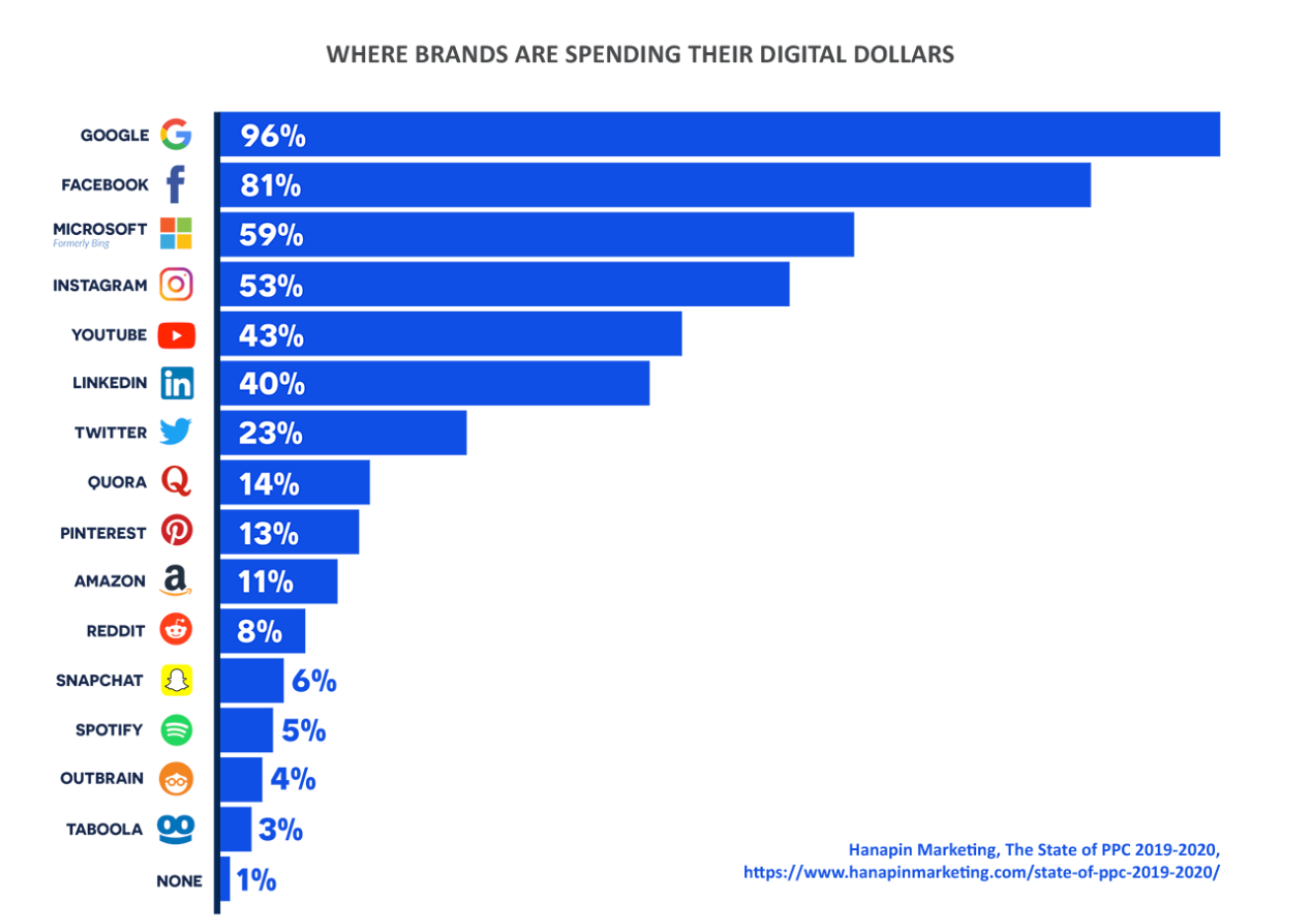 Source: Acquisio
Source: Acquisio
Note that this data is a few years old, but it still provides a nice overview of the networks that are most worth considering if you’re starting out with PPC.
Of course, Google Ads is the obvious first choice for many marketers, with Facebook, Microsoft, Instagram, YouTube, and LinkedIn not too far behind.
If you’re looking to get started with PPC, reading this guide from HubSpot should be helpful.
Or if you feel this is something that’s completely out of your wheelhouse, you can always partner with a SaaS marketing agency that specializes in PPC.
Search Engine Optimization
Here are a few interesting stats that showcase the impact of SEO.
- “68% of online experiences begin with a search engine
- 53.5% of all website traffic comes from organic search
- 92.96% of global traffic comes from Google Search, Google Images, and Google Maps”
This data shows us that the majority of your target audience will find your website through organic search. And further, the lion’s share will use Google as their search engine of choice.
By these numbers, it’s clear that SEO should be a primary marketing channel and one that’s critical for keeping up with competitors.
As for specific components of SEO, there are six main ones to focus on:
- Keyword research to find keywords with adequate search volume and limited competition that you could realistically rank for
- Internal and external linking to build up your link profile
- On-page SEO like using proper URL structure, page titles, and header tags
- Technical SEO, such as site speed, canonical tags, and sitemap URL
- Creating quality, original content
- Mobile SEO to ensure users have an enjoyable experience on both desktop and mobile devices
One of the best things about SEO is the organic nature of it, where any B2B SaaS company with the right know-how can gain valuable search exposure.
That said, making real progress with SEO takes patience and can be time-consuming if done in-house.
For that reason, if you lack the time or experience, you may want to consider partnering with a B2B SaaS marketing agency to handle your SEO.
Social Media Marketing
With 4.9 billion of the world’s 8 billion people using social media in 2023, the sheer volume alone shows the value of using social media marketing as a tactic for growth hacking.
From demand generation for raising brand awareness to creating a connection with your target audience to direct product marketing, social media allows you to do so much.
In terms of ROI, it can vary widely, as numerous factors determine how profitable a campaign is.
But research has found that most businesses see an average return of $2.80 for every dollar spent, making it a smart investment for SaaS marketing.
The question is, which social media platforms should you focus on?
At the top in terms of user volume are Facebook and YouTube, each of which had over 2.5 billion users as of 2023.
After that is Instagram with 2 billion users, TikTok with 1.09 billion, and so on.
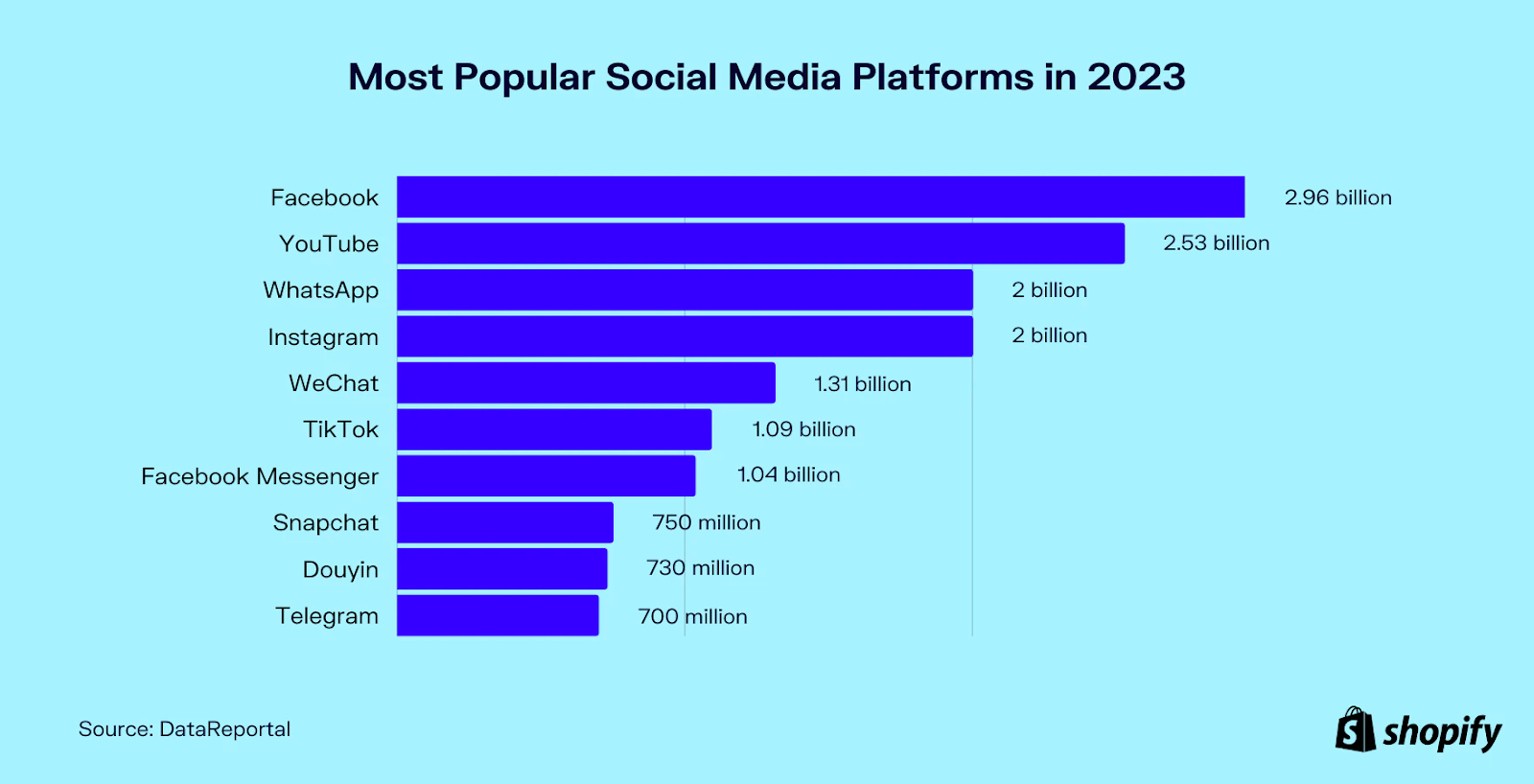 Source: Shopify
Source: Shopify
So these can all be potentially good choices.
And while LinkedIn isn’t quite as big, it can still be a good social media platform with 930 million users, especially when you consider the ease with which companies can connect with one another for streamlined B2B marketing.
Again, if you’re not comfortable with social media, you can always hire a SaaS marketing agency, and many will offer it as a package deal along with PPC, SEO, and other strategies.
Influencer Marketing
It seems it wasn’t that long ago when influencer marketing, where companies collaborate with online influencers to promote their products, was a brand-new marketing tactic used by only a handful of trendsetters.
But in the past few years, it’s basically become ubiquitous, and a growing number of companies across countless industries are now using it, with many getting significant results.
“Most brands that try influencer marketing seem to be happy with the outcomes,” explains Influencer Marketing Hub. “A staggering 90% of respondents to their survey indicated that they believe influencer marketing to be effective. And this statistic has stayed pretty consistent over the years.”
It should be noted that B2B SaaS isn’t usually the first industry that comes to mind with influencer marketing.
Traditionally, it’s primarily been used for e-commerce products.
But it’s recently branched out, and plenty of B2B SaaS brands are using influencer marketing effectively.
Note that influencer marketing doesn’t always have to involve partnering with big-name personalities.
Often partnering with small or even micro-influencers with a loyal, highly engaged following can be just as impactful at a fraction of the cost.
Here’s an example of HubSpot where they hired community-building experts to establish their influencer program using micro-influencers.
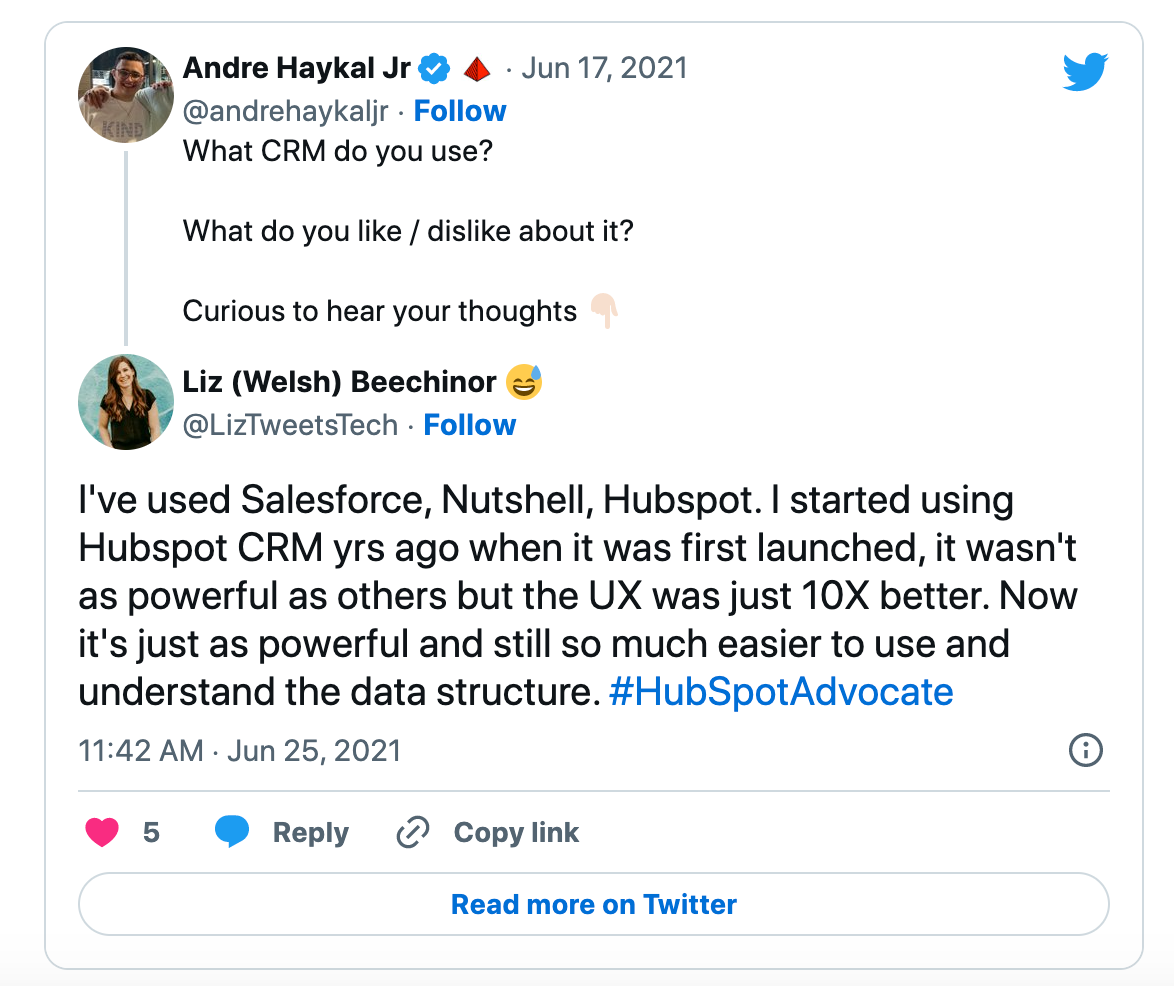 Source: Chantelle Marcelle
Source: Chantelle Marcelle
If you’re looking to get started with influencer marketing, we suggest checking out this guide.
Content Marketing
A recent study found that nearly two-thirds of B2B marketers (73%) used content marketing in their inbound marketing strategy in 2022.
Of those marketers, 91% were successful.
These numbers illustrate the ubiquity of content marketing and that, when done correctly, it can have an immense impact on a B2B marketing campaign.
And it makes sense considering it’s one of the most effective forms of inbound marketing, which relies upon attracting your target audience by creating high-value content that matches their needs.
While outbound marketing, or “push” techniques, still have their place (we’ll discuss cold sales outreach later), using inbound marketing to produce high-quality content is an excellent way to get your brand in front of prospects.
It also helps you work your way through the various touchpoints of the customer journey.
For instance, someone may start by reading a blog post during the awareness stage, then watch a webinar during the consideration stage, then read case studies, and so on, all the way up to making a purchase.
But it doesn’t have to end there.
SaaS content marketing can extend post-purchase to improve the customer experience through how-to videos and increase retention through eBooks and more.
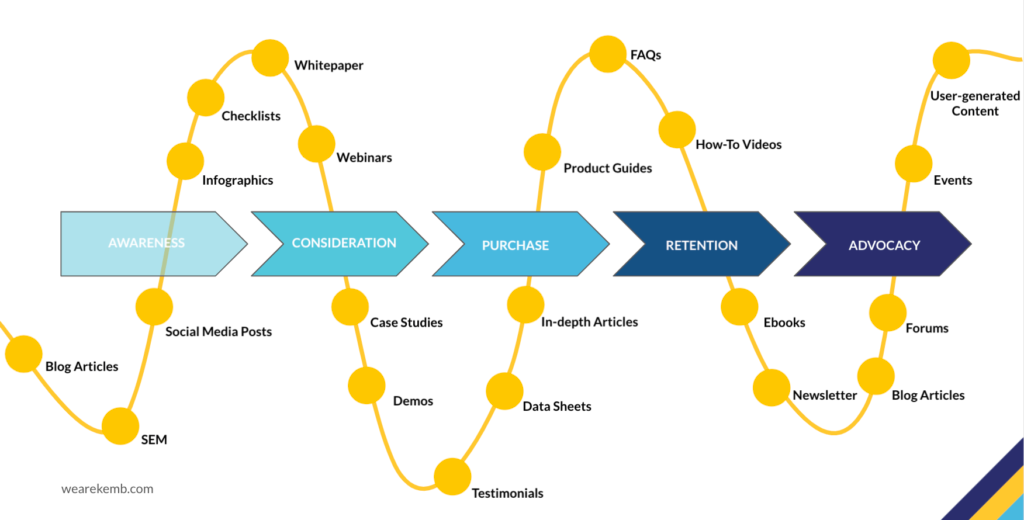 Source: We Are Kemb
Source: We Are Kemb
And as we’ve discussed, providing sustained value over time is critical for B2B SaaS marketing success.
For a detailed overview of how to get started, check out this post that discusses key content marketing strategies.
Email & Marketing Automation
Of all the SaaS marketing strategies available, email marketing has the best ROI with an average of 3,600%!
So for every $1 you put into your email marketing campaign, you can hypothetically expect to earn $36 from it.
That alone is enough reason to use it as part of your marketing strategy.
Also, email marketing is the perfect way to maintain close communication with customers after they’ve made a purchase.
This helps you get their feedback, improve their experience, notify them of additional products or add-ons they may be interested in, and generally build stronger relationships.
And again, this is essential for maximizing customer retention and keeping churn at a minimum.
Taking it one step further, marketing automation allows you to get targeted messaging and content to leads and customers across a variety of channels throughout the entirety of the customer journey.
Email is a prime example where you could use marketing automation to automatically send relevant content to a lead when they need it the most.
If, for instance, someone just made a purchase, you could automatically send them an FAQs email that contained an intuitive product guide.
Or, once a customer hits the one-month mark, you could automatically send them an email asking for their feedback and see if there’s anything you can do to improve their experience.
Marketing automation is a win-win because it provides users with timely, relevant content, and it saves you time because you’re not doing everything manually.
Cold Sales Outreach
Admittedly, cold sales outreach has one of the lowest collective response rates among all B2B SaaS marketing strategies.
The average cold email response rate is only 8.5%.
And the average cold call response rate is even lower, at just 2.5%.
That said, cold sales outreach can still be a viable marketing strategy for many companies as long as it’s done correctly.
This graphic offers some simple yet effective cold-calling tips, which involve using social media for prospecting, calling at the right time, mentioning a common connection, and using multiple follow-ups.
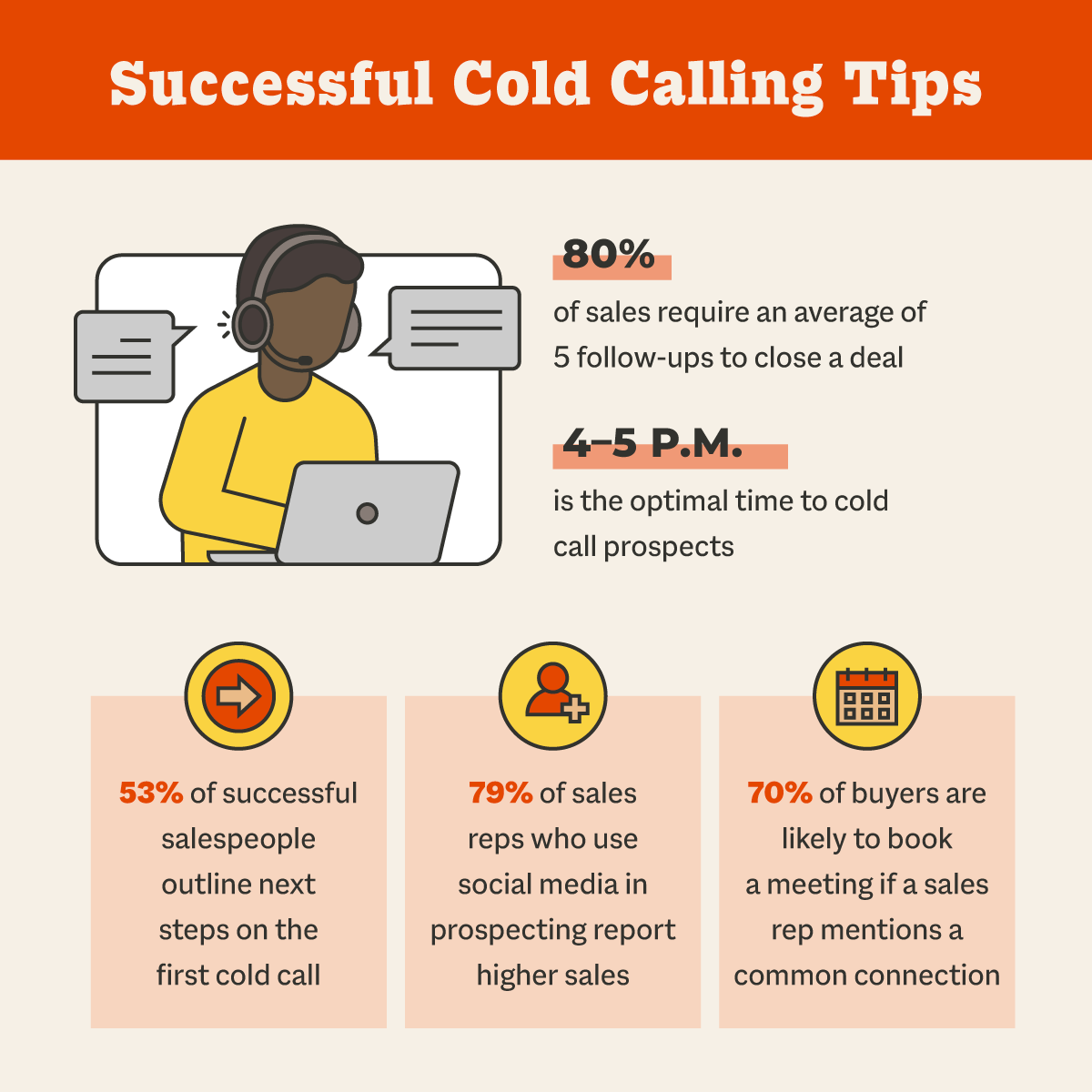 Source: Smith.ai
Source: Smith.ai
Or, if you’re looking to initiate cold outreach through a digital platform, LinkedIn is a great choice, as it’s perfectly suited for B2B SaaS purposes.
Between having instant access to a prospect’s company information and networks, it’s fairly easy to make an introduction and get your foot in the door.
For examples of LinkedIn cold messages that get responses, check out this guide by The Wall Street Journal best-selling author Josh Turner.
Partnerships
Partnerships, or partnership marketing, involve collaborating with another brand with an overlapping demographic to reach a wider percentage of your target audience.
With partnerships, you send a portion of your audience to your partner and vice versa to quickly generate leads.
And because of the built-in trust those new leads have with the B2B SaaS brand you partner with, it’s often easier to build rapport, which can increase your conversion rate.
Just keep in mind that you don’t usually want to partner with a direct competitor, but rather a brand in an industry that’s adjacent to yours.
Take, for instance, the partnership between HubSpot and business financing company, Lendio.
On HubSpot’s Instagram page, they gave a nod to Lendio.
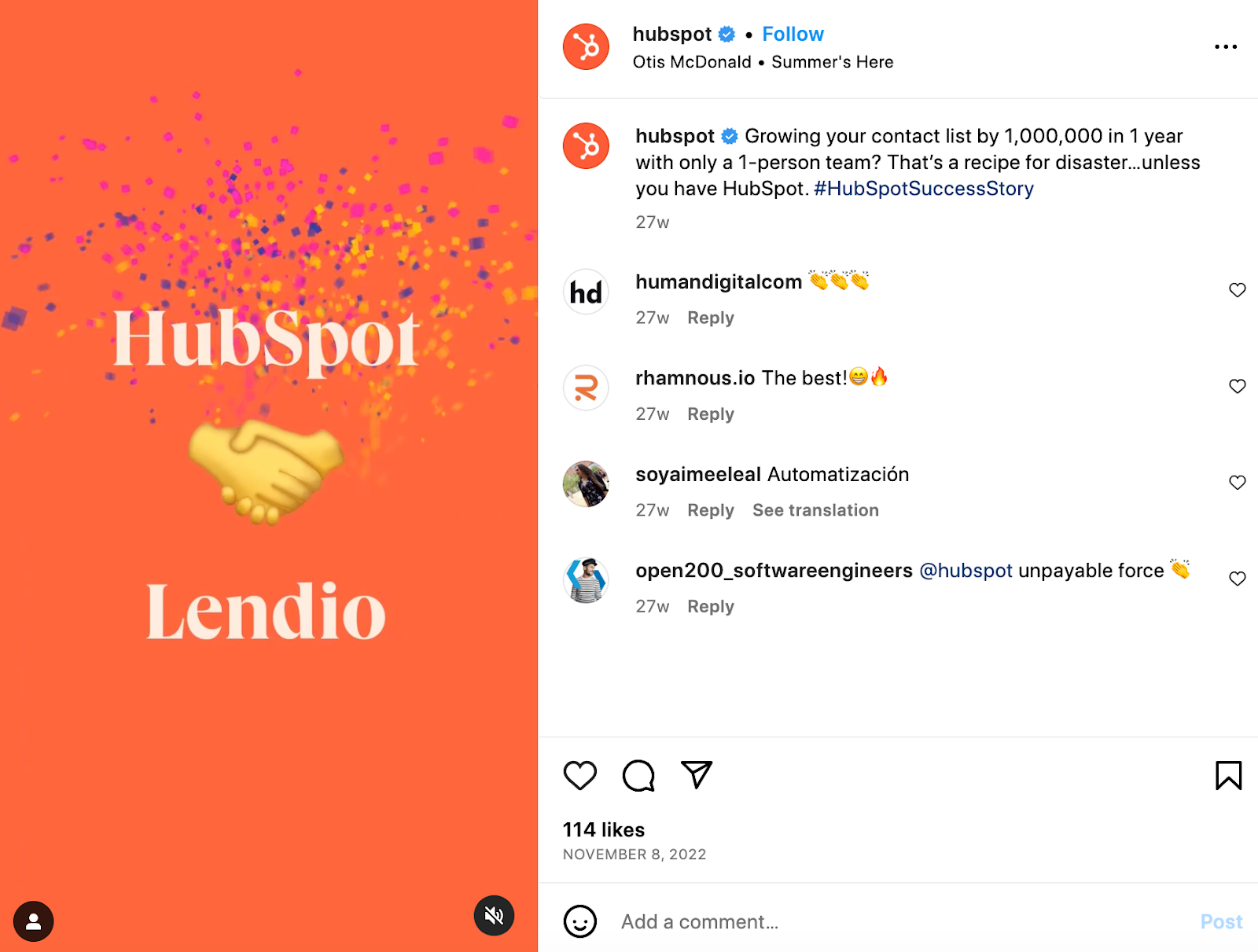 Source: Instagram
Source: Instagram
And considering that HubSpot currently has 498k Instagram followers, you can bet this sent a nice stream of leads Lendio’s way.
Or, look at this webinar from SugarCRM that featured B2B intent machine learning company Bombora and account-based marketing platform, Triblio, where the three brands partnered to discuss the winning formula for sales and marketing.
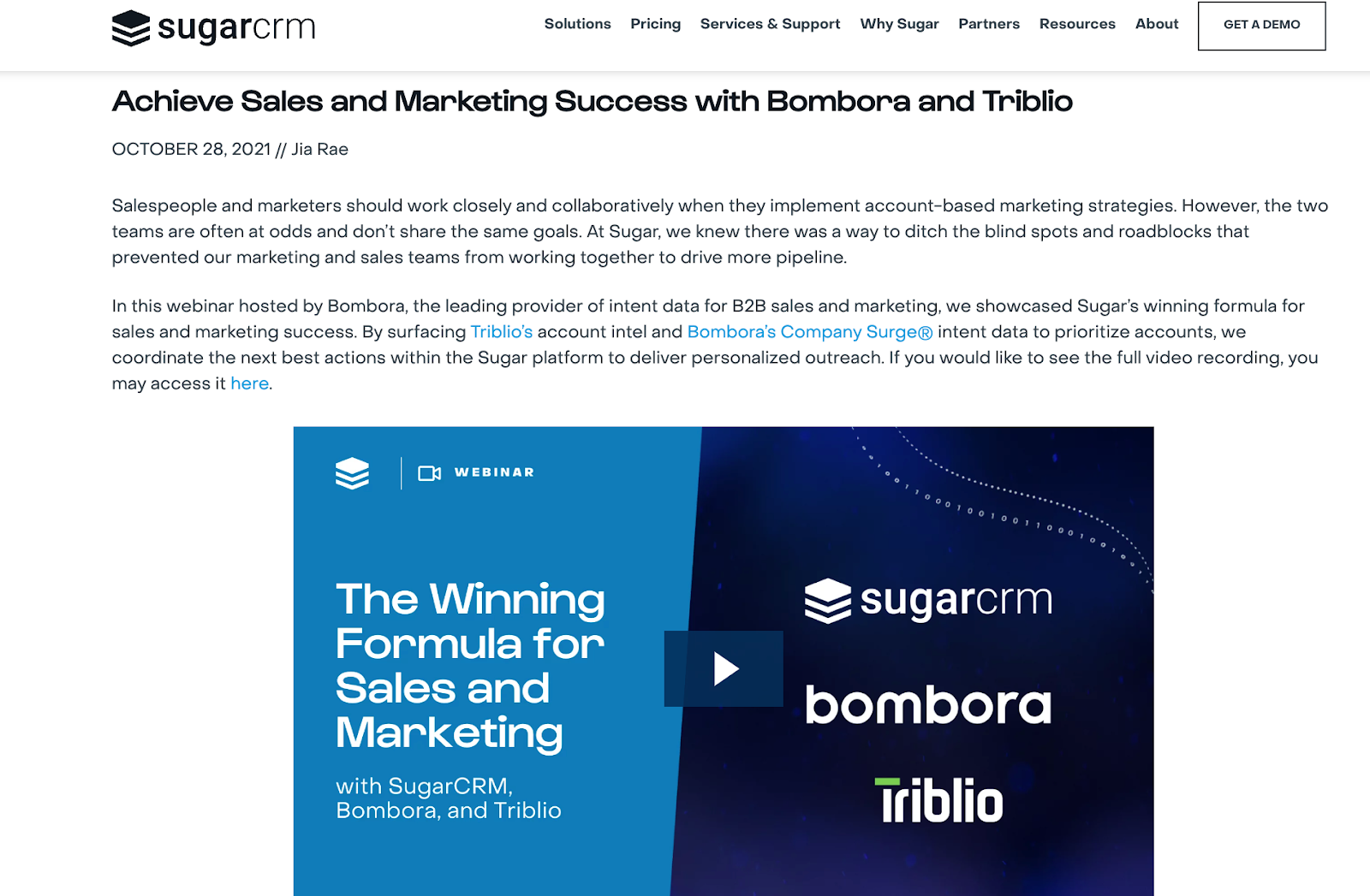 Source: Affise
Source: Affise
And that’s just the tip of the iceberg.
There are countless ways to partner with other brands including:
- Writing guest blog posts
- Doing email swaps where you promote key offerings
- Appearing on each other’s podcasts, videos, or social media pages
- Conducting industry research together
- Collaborating at live events
This brings us to our final B2B SaaS marketing strategy.
Conference Booths
Conference booths are certainly one of the more traditional marketing techniques.
But they can still be an effective way to raise brand awareness and connect with potential customers as well as partners in one fell swoop.
Setting up a booth is the perfect place to show off your SaaS product, provide demonstrations, answer questions, and build buzz around your brand.
Not to mention that it offers the perfect opportunity to connect with people on a one-on-one level and can be the starting point for valuable long-term relationships.
Here’s an example of a conference booth featuring AI-powered support automation platform, Capacity.
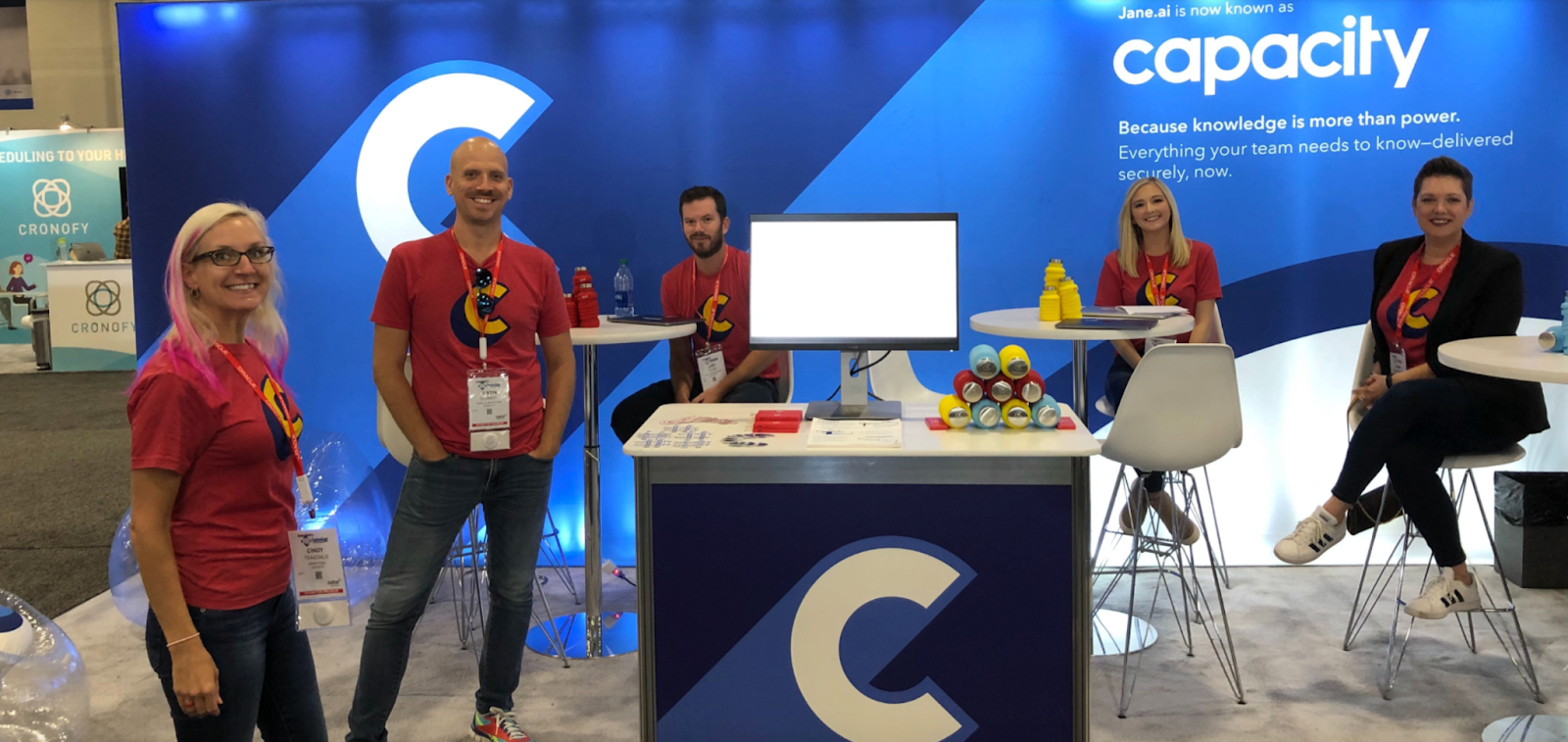 Source: Capacity
Source: Capacity
And here’s another featuring Webex which provides enterprise video conferencing and webinar solutions.
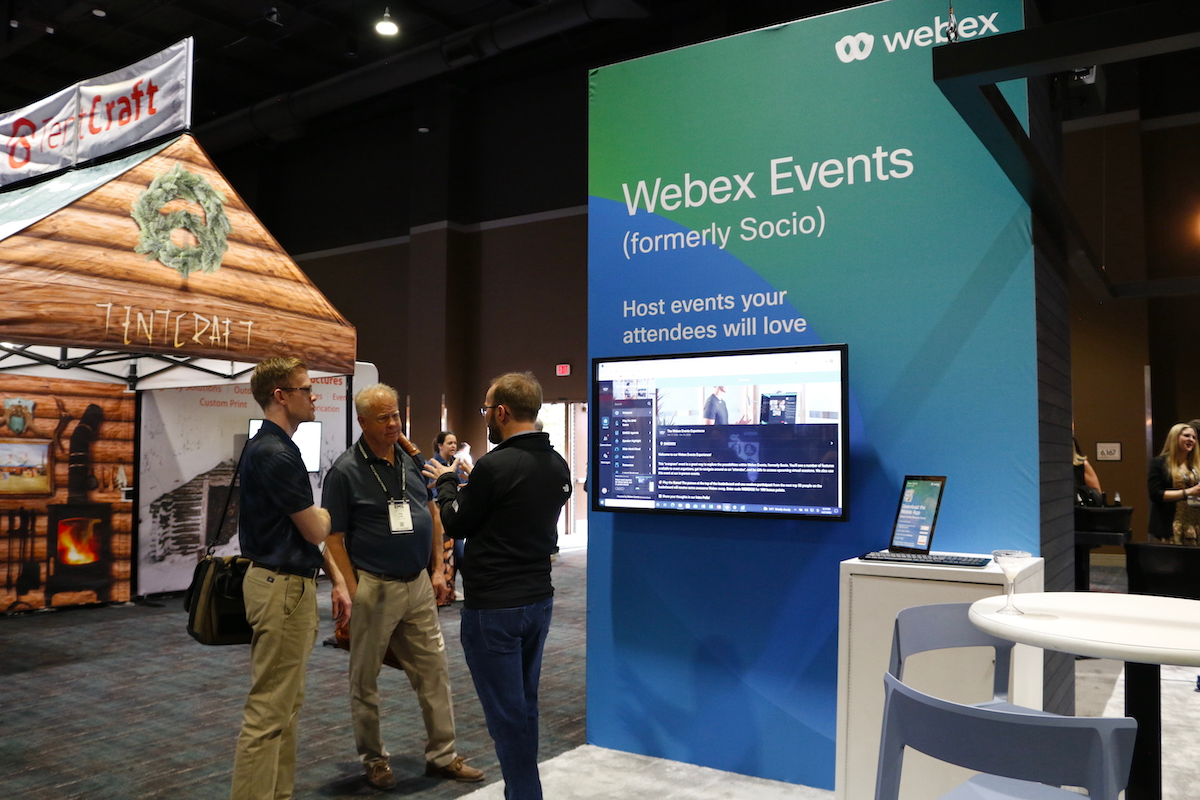 Source: Webex
Source: Webex
While conferences came to a screeching halt during the pandemic, they’re now back in full effect, with events taking place all over the world.
You can find a list of the top 21 SaaS conferences of 2023 here.
Closing Thoughts
Effective B2B SaaS marketing requires engaging users at all stages of the customer journey.
From their initial research to the consideration stage to the purchase stage and beyond, you need a balanced approach that provides a great experience, end-to-end.
And this largely boils down to using the right mix of SaaS B2B marketing strategies.
By doing so, you can increase your lead volume, turn more leads into customers, and retain more customers for longer, keeping your B2B SaaS business firing on all cylinders.



